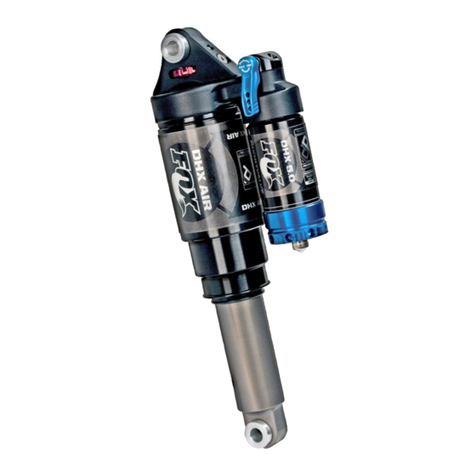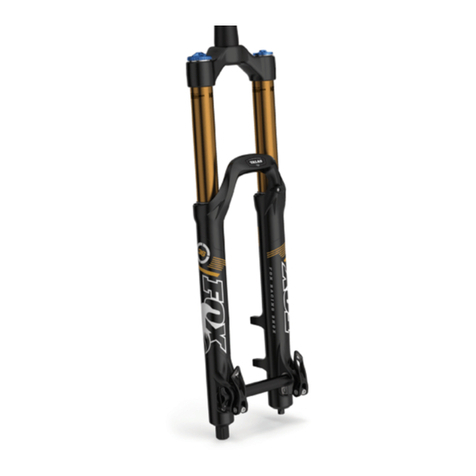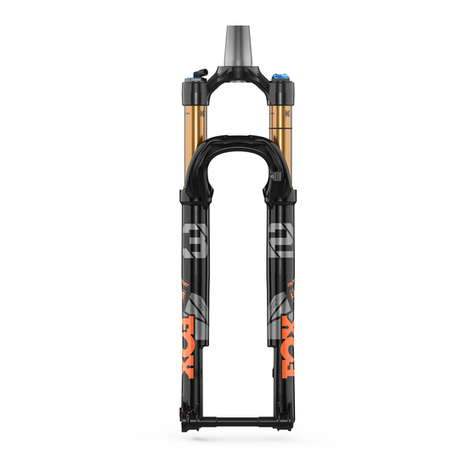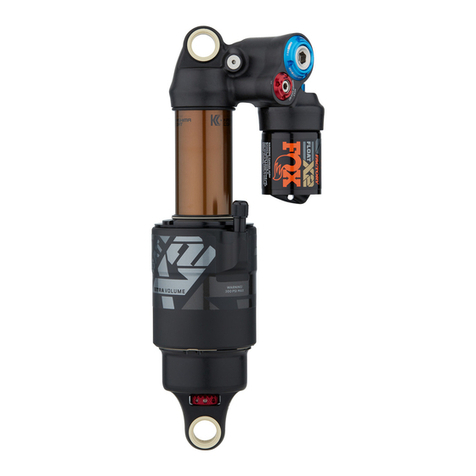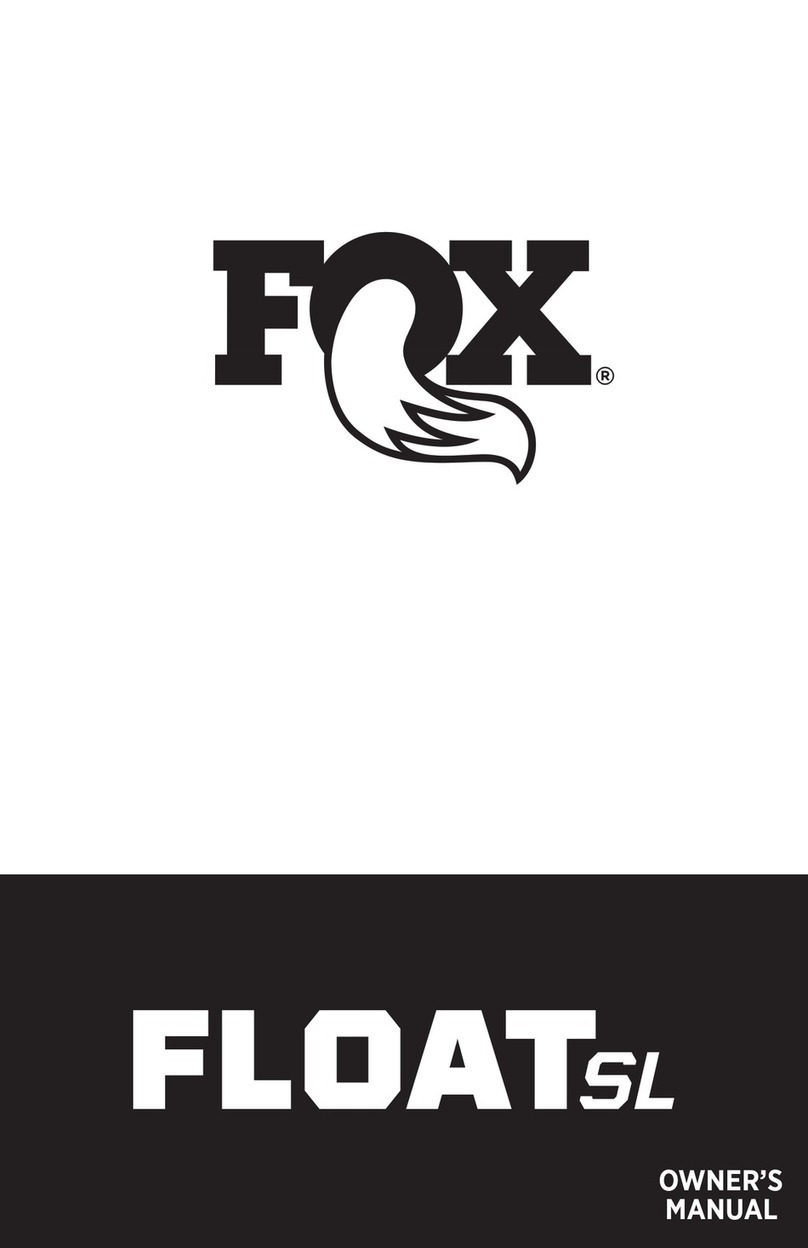34 FLOAT 29
Installing Your Fork | Before You Ride | Setting Sag | Adjusting Rebound | Climb. Trail. Descend. | Adjusting Trail Mode | Service Intervals | Important Safety Information
travel •5.5 in./140 mm
•5.9 in./150 mm
model
features,
adjustments
Factory FIT CTD with Trail Adjust; 140,
150: Kashima coated or hard anodized
upper tubes, 1.5" tapered steerer, lever
actuated 3-position Climb/Trail/Descend, 3-
position Trail Adjust, air spring pressure,
rebound
Factory FIT CTD Remote; 140, 150:
Kashima coated or hard anodized upper
tubes, 1.5" tapered steerer, remotely
actuated 3-position Climb/Trail/Descend, air
spring pressure, rebound
Performance FIT CTD; 140, 150: Hard
anodized upper tubes, 1.5" tapered steerer,
lever actuated 3-position Climb/Trail/
Descend, air spring pressure, rebound
Evolution O/C CTD Remote; 140, 150:
Hard anodized upper tubes, 1.5" tapered
steerer, remotely actuated 3-position Climb/
Trail/Descend, air spring pressure, rebound
Evolution O/C CTD; 140, 150: Hard
anodized upper tubes, 1.5" tapered steerer,
lever actuated 3-position Climb/Trail/
Descend, air spring pressure, rebound
lower leg 15QR thru axle system, post style disc brake
mounting
spring air
riding style trail, AM
Installing Your Fork
Be sure your fork is properly installed before proceeding. If your fork came pre-installed on your bicycle, continue to the next section.
Before You Ride
1. Check that quick-release levers are properly adjusted and tightened.
2. Clean the outside of your fork with only mild soap and water, and wipe dry with a soft dry rag. NOTE: Do not use any solvents or de-greasers, as these products can cause serious
damage to paint and anodized parts (upper tubes, knobs, steerers).
Do not spray water directly on the seal/upper tube junction. Do not use a high pressure washer on your fork.
3. Inspect the entire exterior of your fork. The fork should not be used if any of the exterior parts appear to be damaged. Contact your local dealer or FOX Racing Shox for further inspection
and repair.
4. Check your headset adjustment. If loose, adjust it accordingly to your bicycle manufacturer's recommendations.
5. Check that all brake cables or hoses are properly fastened.
6. Test the proper operation of your front and rear brakes on level ground.
Setting Sag
To get the best performance from your fork, it is necessary to set the proper air spring pressure by adjusting sag. Generally, sag should be set to 15-25% of total fork travel.
1. Unscrew the blue aircap on top of the left fork leg to expose the Schrader valve.
2. Attach a FOX Racing Shox High Pressure Pump to the Schrader valve.
3. Pump your fork to the appropriate setting from the Suggested Air Spring Pressure Settings table below, then remove the pump. TIP: Use your air spring PSI value in "34 FLOAT 29" only
as a starting point. Discovering your best sag value is a process that takes some time to fully discover, given your riding style, bike geometry, total weight, and suspension feel
preferences.
4. Unless your fork already has a sag setting o-ring on an upper tube, install a zip tie to an upper tube. Slide the o-ring or the zip tie down against the scraper lip of the fork dust seal.
5. Make sure your fork is in Descend mode (fully counter-clockwise).
6. Dressed to ride, position your bike next to a wall or table to support yourself. Without bouncing, mount your bicycle. Assume a normal riding position for at least 30 seconds, allowing the
suspension to fully settle.
7. Dismount your bike without bouncing downward, without further moving the o-ring or zip tie. Measure the distance between the seal and the zip tie. This measurement is your sag value.
8. Compare your actual sag value to your target sag value in the Sag Setup table below.
If your sag value is less than the table value, screw on the pump fitting, note the current air pressure setting and depress the black bleed-valve to reduce the gauge pressure by 5 psi.
Measure sag again and repeat this adjustment, if necessary.
If your sag value is greater than the table value, screw on the pump fitting, note the current air pressure setting and pump to increase the gauge pressure by 5 psi. Measure sag again
and repeat this adjustment if necessary.
9. Screw the blue aircap back on.
10. Rider
Weight
lbs.
11. Suggested Air Spring Pressure Settings
PSI
12. 140 mm 13. 150 mm
14. ≤125 15. 45 16. 40
17. 125 - 135 18. 50 19. 45
20. 135 - 145 21. 55 22. 50
23. 145 - 155 24. 65 25. 60
26. 155 - 170 27. 70 28. 65
29. 170 - 185 30. 75 31. 70
32. 185 - 200 33. 80 34. 80
35. 200 - 215 36. 90 37. 90
38. 215 - 230 39. 100 40. 100
41. 230 - ≥250 42. 110 43. 110
44.
45. Sag Setup
46. Travel 47. XC/Race FIRM 48. All-Mountain PLUSH
49. 140 mm (5.5") 50. 21 mm (0.83") 51. 35 mm (1.38")
52.
53. Sag Troubleshooting
54. Symptom 55. Remedy
56. Too much sag 57. (+) air pressure in 5 psi increments
58. Too little sag 59. (-) air pressure in 5 psi increments
60. Excessive bottoming 61. (+) air pressure in 5 psi increments
62. Harsh ride; full travel not utilized 63. (-) air pressure in 5 psi increments
